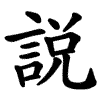説
| ||||||||
Translingual
[edit]| Stroke order | |||
|---|---|---|---|

| |||
| Traditional | 說 |
|---|---|
| Shinjitai | 説 |
| Simplified | 说 |
Han character
[edit]説 (Kangxi radical 149, 言+7, 14 strokes, cangjie input 難卜口金口 (XYRCR) or 卜口金口山 (YRCRU), composition ⿰訁兑)
Derived characters
[edit]Related characters
[edit]- 說 (Traditional form used in Taiwan, also the orthodox form in Kangxi dictionary)
Usage notes
[edit]説 is not encoded in the Big5 character set for traditional Chinese characters.
References
[edit]- Kangxi Dictionary: not present, would follow page 1165, character 5
- Dai Kanwa Jiten: character 35556
- Hanyu Da Zidian (first edition): volume 6, page 3979, character 3
- Unihan data for U+8AAC
Chinese
[edit]Definitions
[edit]| For pronunciation and definitions of 説 – see 說 (“to say; to speak; to explain; etc.”). (This character is a variant traditional form of 說). |
Usage notes
[edit]This character is the preferred form used in Hong Kong. It is also the traditional form of 说 used in mainland China.
Japanese
[edit]| 説 | |
| 說 |
Kanji
[edit](Fourth grade kyōiku kanji, shinjitai kanji, kyūjitai form 說)
Readings
[edit]From Middle Chinese 說 (MC sywet); compare Mandarin 說/说 (shuō):
From Middle Chinese 說 (MC sywejH); compare Mandarin 說/说 (shuì):
From Middle Chinese 說 (MC ywet); compare Mandarin 說/说 (yuè):
From native Japanese roots:
- Kun: とく (toku, 説く, Jōyō)、よろこぶ (yorokobu, 説ぶ)、よろこばしい (yorokobashii, 説ばしい)
- Nanori: あき (aki)、かぬ (kanu)、かね (kane)、こと (koto)、さとし (satoshi)、つぐ (tsugu)、とき (toki)、とく (toku)、のぶ (nobu)、ひさ (hisa)
Compounds
[edit]- 説明 (setsumei): an explanation; to explain
- 説得 (settoku): persuasion, persuade
- 説得力 (settokuryoku): persuasive force, persuasiveness
- 逆説 (gyakusetsu): a paradox
- 仏説 (bussetsu): the sayings or teachings of Buddha
Etymology
[edit]| Kanji in this term |
|---|
| 説 |
| せつ Grade: 4 |
| kan'on |
| Alternative spelling |
|---|
| 說 (kyūjitai) |
From Middle Chinese 說 (MC sywet).
Pronunciation
[edit]Noun
[edit]References
[edit]Korean
[edit]Hanja
[edit]説 • (seol, se, yeol) (hangeul 설, 세, 열, revised seol, se, yeol, McCune–Reischauer sŏl, se, yŏl, Yale sel, sey, yel)
- This term needs a translation to English. Please help out and add a translation, then remove the text
{{rfdef}}.
Vietnamese
[edit]Han character
[edit]説: Hán Nôm readings: thuyết, thót, thốt
- This term needs a translation to English. Please help out and add a translation, then remove the text
{{rfdef}}.
References
[edit]- CJK Unified Ideographs block
- Han script characters
- CJKV characters simplified differently in Japan and China
- Translingual lemmas
- Translingual symbols
- Beginning Mandarin
- zh:Talking
- Chinese lemmas
- Mandarin lemmas
- Sichuanese lemmas
- Dungan lemmas
- Cantonese lemmas
- Taishanese lemmas
- Gan lemmas
- Hakka lemmas
- Jin lemmas
- Eastern Min lemmas
- Hokkien lemmas
- Teochew lemmas
- Wu lemmas
- Xiang lemmas
- Middle Chinese lemmas
- Old Chinese lemmas
- Chinese hanzi
- Mandarin hanzi
- Sichuanese hanzi
- Dungan hanzi
- Cantonese hanzi
- Taishanese hanzi
- Gan hanzi
- Hakka hanzi
- Jin hanzi
- Eastern Min hanzi
- Hokkien hanzi
- Teochew hanzi
- Wu hanzi
- Xiang hanzi
- Middle Chinese hanzi
- Old Chinese hanzi
- Chinese verbs
- Mandarin verbs
- Sichuanese verbs
- Dungan verbs
- Cantonese verbs
- Taishanese verbs
- Gan verbs
- Hakka verbs
- Jin verbs
- Eastern Min verbs
- Hokkien verbs
- Teochew verbs
- Wu verbs
- Xiang verbs
- Middle Chinese verbs
- Old Chinese verbs
- Chinese nouns
- Mandarin nouns
- Sichuanese nouns
- Dungan nouns
- Cantonese nouns
- Taishanese nouns
- Gan nouns
- Hakka nouns
- Jin nouns
- Eastern Min nouns
- Hokkien nouns
- Teochew nouns
- Wu nouns
- Xiang nouns
- Middle Chinese nouns
- Old Chinese nouns
- Chinese terms spelled with 説
- Chinese variant forms
- Japanese kanji
- Japanese fourth grade kanji
- Japanese kyōiku kanji
- Japanese jōyō kanji
- Japanese terms derived from Middle Chinese
- Japanese kanji with goon reading せち
- Japanese kanji with kan'on reading せつ
- Japanese kanji with goon reading せ
- Japanese kanji with kan'on reading せい
- Japanese kanji with kan'yōon reading ぜい
- Japanese kanji with kan'yōon reading せつ
- Japanese kanji with goon reading えち
- Japanese kanji with kan'on reading えつ
- Japanese kanji with kun reading と・く
- Japanese kanji with kun reading よろこ・ぶ
- Japanese kanji with kun reading よろこ・ばしい
- Japanese kanji with nanori reading あき
- Japanese kanji with nanori reading かぬ
- Japanese kanji with nanori reading かね
- Japanese kanji with nanori reading こと
- Japanese kanji with nanori reading さとし
- Japanese kanji with nanori reading つぐ
- Japanese kanji with nanori reading とき
- Japanese kanji with nanori reading とく
- Japanese kanji with nanori reading のぶ
- Japanese kanji with nanori reading ひさ
- Japanese terms spelled with 説 read as せつ
- Japanese terms read with kan'on
- Japanese terms with IPA pronunciation
- Japanese lemmas
- Japanese nouns
- Japanese terms spelled with fourth grade kanji
- Japanese terms with 1 kanji
- Japanese terms spelled with 説
- Japanese single-kanji terms
- Japanese terms with usage examples
- Korean lemmas
- Korean hanja
- Vietnamese lemmas
- Vietnamese Han characters